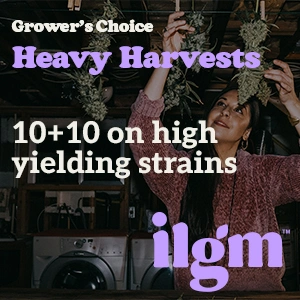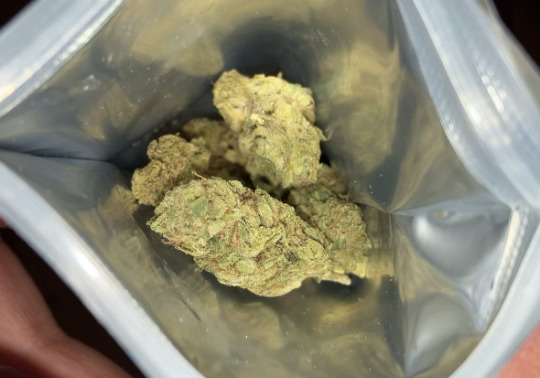#cannabisresearch
Explore tagged Tumblr posts
Text
THC-Free Terpenes for Pain Relief
Researchers at the University of Arizona Health Sciences have found that terpenes from Cannabis sativa may provide effective pain relief for fibromyalgia and post-surgical pain without THC’s psychoactive effects. The study, published in Pharmacological Reports, highlights geraniol as the most promising compound among the four tested terpenes—geraniol, linalool, beta-caryophyllene, and alpha-humulene.
website: https://popularscientist.com/
0 notes
Text
What Are Cannabis Alkaloids? Their Role, Benefits, and Untapped Potential



Unlocking the Secrets of Cannabis Alkaloids: A Hidden Chemical Powerhouse
THC and CBD may dominate the spotlight, but hidden within cannabis is another class of compounds with untapped potential—alkaloids.Could these lesser-known chemicals be the key to unlocking new therapeutic and recreational benefits?Understanding cannabis alkaloids could lead to groundbreaking discoveries in medical and recreational cannabis use.What Are Alkaloids in Plants?Alkaloids are nitrogen-containing compounds naturally produced by plants and fungi.These compounds serve various biological functions, such as deterring herbivores, aiding reproduction, and protecting plants from environmental threats.Many alkaloids have powerful effects on the human body and have been used in medicine, recreation, and spirituality for centuries.Common Alkaloids in Other PlantsTo understand the significance of alkaloids, let’s look at a few well-known examples: Alkaloid Found In Effects Caffeine Coffee, Tea Enhances alertness & energy Morphine Poppies Potent pain-relieving opioid Nicotine Tobacco Addictive stimulant affecting mood & cognition Psilocybin Magic Mushrooms Alters perception & mood If these alkaloids can exert such profound effects, could cannabis alkaloids hold similar potential? Why Does Cannabis Produce Alkaloids?Although cannabis alkaloids remain understudied, we can make informed speculations about their purpose by examining alkaloid production in other plants. These compounds likely serve multiple functions essential to the plant’s survival and adaptation:- Defense Against Predators: Alkaloids deter herbivores by making plants taste bitter or, in some cases, toxic. This defense mechanism protects cannabis from insects, animals, and other threats. - Protection Against Environmental Stress: Extreme temperatures, droughts, and nutrient deficiencies pose significant challenges to plant survival. Alkaloids may act as biochemical shields, helping cannabis withstand harsh environmental conditions. - Competitive Advantage (Allelopathy): Some plants use alkaloids to suppress the growth of neighboring plants, giving them a competitive edge in their ecosystem. - Enhancing Reproductive Success: Alkaloids might play a role in attracting beneficial pollinators or deterring harmful ones, increasing the likelihood of successful reproduction.By exploring these potential roles, researchers can better understand why cannabis evolved to produce alkaloids and how they might contribute to the plant’s effects.Alkaloids Found in CannabisWhile cannabinoids and terpenes dominate cannabis research, scientists have also identified several alkaloids in the plant. These compounds may play a crucial role in cannabis’ biological functions and potential effects.1. Cannabisativine:Cannabisativine is a pyrrolidine-based alkaloid believed to aid in plant defense against pests and pathogens. It may also serve as a nutrient reservoir, helping the plant manage essential compounds for growth and survival. Although little is known about its effects on humans, its presence highlights cannabis' biochemical diversity.2. Cannabimines (A, B, C, and D):Cannabimines exhibit unique molecular structures that may contribute to the plant’s stress tolerance and defensive mechanisms. Some researchers speculate that cannabimines might interact with human receptors or enzymes, potentially influencing physiological responses, though scientific research is still in its early stages.3. Cannabinine:Cannabinine has been studied for its potential effects on the human nervous system, with researchers investigating its interaction with neurotransmitter pathways.Early studies suggest it may have pharmacological effects, but further research is needed to confirm its role in cannabis' overall impact.4. Tetanocannabin:Tetanocannabin helps the plant withstand environmental stressors like extreme temperatures and soil conditions.Scientists are particularly interested in whether this compound can interact with human neurotransmitters, influencing mood, perception, or other physiological functions.


Can Alkaloids Enhance the Entourage Effect?The entourage effect refers to the combined impact of all active compounds in cannabis working together.Ever wondered why different strains of cannabis have different effects? It’s due to their unique ratios of cannabinoids, terpenes, flavonoids, and, potentially, alkaloids.While there is no direct evidence linking alkaloids to the entourage effect, their potential role cannot be dismissed. Alkaloids may influence cannabinoid activity or interact with relevant receptors, modulating mood, perception, and other effects.These interactions could complement cannabinoids and terpenes, enhancing the overall experience—or not.Future research will determine whether alkaloids are an integral part of this synergy.Potential Benefits of Cannabis AlkaloidsResearch into cannabis alkaloids is still emerging, but they may offer several benefits:- Pain Relief: Like morphine, some alkaloids may interact with pain receptors, potentially enhancing cannabis' analgesic effects. - Anti-Inflammatory Properties: Similar to other plant alkaloids, they might help reduce inflammation, complementing CBD in conditions like arthritis. - Neuroprotection & Antioxidants: Certain alkaloids may protect brain cells, supporting cognitive health and potentially aiding in neurodegenerative diseases. - Mood & Mental Health Support: If cannabis alkaloids interact with neurotransmitters, they could influence mood, anxiety, and depression, similar to psilocybin. - Medical Advancements: Studies may uncover therapeutic uses for pain, inflammation, and brain health, leading to new plant-based medicines. - Enhanced Cannabis Strains: Understanding alkaloid interactions could help create strains with tailored psychoactive effects, mood enhancement, or fewer side effects. - Optimized Cultivation: Identifying factors that influence alkaloid production may lead to improved growing techniques for specialized cannabis varieties.Final ThoughtsCannabis is an incredibly complex plant, producing a vast range of bioactive compounds. While cannabinoids like THC and CBD have taken center stage, alkaloids may hold untapped potential for both medical and recreational use.As science advances, we may soon discover that cannabis alkaloids are just as important as cannabinoids in shaping the plant’s effects.Would you like to stay updated on new discoveries in cannabis science? Follow our blog for the latest research and insights!Share this blog with fellow enthusiasts, and don’t forget to subscribe for more updates!
Frequently Asked Questions (FAQ) Marijuana Alkaloids
What are cannabis alkaloids? Cannabis alkaloids are nitrogen-containing compounds naturally produced by the cannabis plant.While not as well-known as cannabinoids like THC or CBD, alkaloids may contribute to plant defense mechanisms and have potential pharmacological effects in humans. Do cannabis alkaloids have psychoactive effects? Unlike THC, most cannabis alkaloids do not seem to be highly psychoactive. However, their interactions with other cannabis compounds, such as cannabinoids and terpenes, are still being studied and may influence the overall effects of cannabis. How do weedcannabis alkaloids compare to cannabinoids? Cannabinoids, such as THC and CBD, primarily interact with the body’s endocannabinoid system, influencing mood, pain, and appetite.In contrast, alkaloids may engage with multiple biological pathways, including neurotransmitter systems, potentially affecting mood, cognition, and physiological functions. Can cannabis alkaloids be used medicinally? Although research is in its early stages, some cannabis alkaloids may possess therapeutic potential. Preliminary studies suggest they could have anti-inflammatory, neuroprotective, and even pain-relieving properties, but more research is needed to confirm their medical applications. Are cannabis alkaloids part of the entourage effect? While there is no definitive evidence yet, some researchers speculate that alkaloids may contribute to the entourage effect—a phenomenon where cannabis compounds work synergistically to enhance therapeutic benefits. How can I maximize the benefits of cannabis alkaloids? Since the science of cannabis alkaloids is still developing, the best way to potentially experience their benefits is by consuming full-spectrum cannabis products.These products contain a diverse range of cannabinoids, terpenes, flavonoids, and alkaloids, offering a more holistic cannabis experience. Are cannabis alkaloids found in all cannabis strains? The presence and concentration of alkaloids in cannabis can vary significantly between strains. Environmental factors, genetics, and cultivation methods may all influence alkaloid production. Do cannabis alkaloids have any side effects? Currently, little is known about the potential side effects of cannabis alkaloids.However, like other plant-derived alkaloids, they may have bioactive effects that could impact human physiology. Further research is needed to assess their safety profile. Can cannabis alkaloids be extracted and isolated? Yes, in theory, cannabis alkaloids can be extracted and isolated, similar to how cannabinoids and terpenes are.However, due to their low concentration and limited research, there are currently no mainstream extraction methods focused on cannabis alkaloids. Are there any legal restrictions on cannabis alkaloids? Most legal frameworks focus on cannabinoids like THC and CBD rather than alkaloids.However, as research into cannabis alkaloids progresses, regulatory considerations may evolve. Do cannabis alkaloids affect the taste or aroma of cannabis? Unlike terpenes, which directly contribute to cannabis’ aroma and flavor, alkaloids are more likely to impact the plant’s biological functions rather than its sensory characteristics.However, their presence may subtly influence the overall chemical profile. What are the Functions of Alkaloids in Plants? Read the full article
#Cannabinoids#cannabisalkaloids#cannabisbenefits#cannabisblog#cannabiscompounds#CannabisEffects#cannabisindustry#cannabismedicine#CannabisResearch#cannabisscience#CBD#entourageeffect#full-spectrumcannabis#MEDICALCANNABIS#plantalkaloids#THC
0 notes
Text
Canada Legal Cannabis Market Dynamics: Analyzing Current Size, Share, and Growth Trends
The Canada legal cannabis market size is expected to reach USD 5.79 billion by 2030, registering a CAGR of 10.1% from 2024 to 2030, according to a new report by Grand View Research, Inc. Growing awareness of the health benefits related to cannabis and CBD consumption for treating anxiety & seizures and reducing pain is projected to propel the market growth. The high demand for CBD for health and wellness purposes, attributed to its therapeutic properties, is a key driver in the market's growth.

Moreover, the rising number of clinical trials signifies the positive effects of utilizing cannabis for treating various medical conditions. For instance, in February 2024, researchers at the University of British Columbia introduced a first-of-its-kind clinical trial examining the potential of CBD as a treatment for bipolar depression. The trials were approved by Health Canada and funded by the Canadian Institutes of Health Research (CIHR) to investigate how CBD can help manage acute bipolar depression.
Canada Legal Cannabis Market Report Highlights
Based on source, the marijuana segment dominated the market in 2023 and is anticipated to witness the fastest growth over the forecast period owing to the growing adoption of marijuana-based products
Based on derivatives, the CBD segment held the largest market share in 2023, owing to the awareness regarding CBD's effectiveness in treating various medical conditions
Based on cultivation, the indoor segment held the largest market share in 2023 due to the incorporation of artificial intelligence (AI) in cannabis cultivation, rising investments, and favorable government initiatives
Based on end use, the recreational segment dominated the market in 2023 and is anticipated to grow at the fastest CAGR over the forecast period due to the growing consumption of cannabis in the form of vapes, foods, and beverages
For More Details or Sample Copy please visit link @: Canada Legal Cannabis Market Report
Moreover, medical professionals' increasing preference for cannabinoid-based formulations to treat numerous health conditions is another major factor supporting the country's market. Healthcare professionals' higher preference for CBG, CBN-derived products creates a positive influence on consumer minds, thereby boosting their adoption rate and popularity. For instance, in October 2021, Cronos Group Inc. launched its SPINACH FEELZ Chill Bliss 2:1 THC|CBG gummy that features THC and cultured CBG.
Some of the key players in the market are Canopy Growth Corporation, Charlotte's Web, Inc., Aurora Cannabis, Tilray Brands, The Cronos Group, Jazz Pharmaceuticals, Inc., Sundial Growers, and Maricann, Inc. These market players adopt key strategic initiatives to expand their business footprint and market position. For instance, in April 2023, Aurora Cannabis Inc. partnered with Strainprint and announced the launch of the tracking program through Strainprint App. The tracking program is designed for Aurora patients to keep track of their medical cannabis journey.
Furthermore, the rise in awareness regarding cannabis and its potential use in various industries and the introduction of educational programs boost the market growth. For instance, in July 2022, Tilray Brands launched a cannabis education platform, WeCare-Medical Cannabis. The platform is dedicated to educating patients and healthcare practitioners about medical cannabis.
List of major companies in the Canada Legal Cannabis Market
Canopy Growth Corporation
Charlotte's Web, Inc.
Aurora Cannabis Inc.
Tilray Brands
The Cronos Group
Jazz Pharmaceuticals, Inc.
Sundial Growers
Organigram Holding, Inc.
Maricann, Inc.
For Customized reports or Special Pricing please visit @: Canada Legal Cannabis Market Analysis Report
We have segmented the Canada legal cannabis market on the basis of source, derivatives, cultivation, end-use, and region.
#LegalCannabisCanada#CannabisMarket#CannabisIndustry#CanadaCannabis#CannabisLegalization#CannabisRetail#CannabisResearch#MedicalCannabis#RecreationalCannabis#CannabisTrends#CannabisRegulations#CannabisCultivation#CannabisDistribution#CBDCanada#THCProducts#CannabisPolicy#CannabisEconomy#CannabisStocks
0 notes
Text
Cannabis industry predictions for the next decade in Canada and USA
The cannabis industry has undergone remarkable changes in recent years, and as we look ahead, it’s clear that the next decade will bring even more transformation. Both Canada and the United States are at the forefront of this evolving landscape, with legalization, technological advancements, and shifts in consumer behavior all playing significant roles.
#CannabisIndustry #CannabisPredictions #CannabisLegalization #CannabisInnovation #SustainableCannabis #MedicalCannabis #CannabisResearch #CannabisEconomy #CannabisTech #Cannabis
#CannabisIndustry#CannabisPredictions#CannabisLegalization#CannabisInnovation#SustainableCannabis#MedicalCannabis#CannabisResearch#CannabisEconomy#CannabisTech#Cannabis
0 notes
Photo

The plays a crucial role in regulating various physiological and cognitive processes, and may help reduce inflammation and protect the brain from damage caused by cerebral palsy. 🤔🧠
0 notes
Text
THC Gummies and Anxiety: Exploring the Connection 🌿😌
Delve into the relationship between THC gummies and anxiety. Learn about the potential effects, benefits, and considerations when using these products.
Refer Link - https://justpaste.it/thc-gummies-and-anxiety
#THCGummies#AnxietyRelief#CannabisAndMentalHealth#THCProducts#CannabisWellness#AnxietyManagement#CannabisEffects#HolisticHealth#CannabisResearch#WellnessInsights
0 notes
Text

Gelonade
Personal review of Gelonade
Gelonade is a strain very unique, coming in with an average 24 THC percentage and is a cross between Lemon Tree and Gelato #41. It has sweet and earthy tones to it and all around is an enjoyable smoke. Personal review of the strain Gelonade
My personal takeaways from this strain were very enjoyable. This strain has a very enjoyable head and body high, helping me relax and feel less anxious while I was still able to smoke and do tasks I needed to do.
I personally like to test the way a high feels on me by being able to do tasks around the home ; cleaning, cooking, organizing and other chores. Seeing if I’m staying on task or if I find myself drifting away. The second test I like to do is sitting down and playing a puzzle game. Seeing how long said game will take me and if I have the attention span to finish it.
Gelonade helped with my focus of completing house hold chores and focusing on puzzles for long periods of time. One of the downsides to Gelonade in my personal opinion was the high personally did not last very long and only stayed peek for half a hour to forty minutes and made me incredibly hungry, That is a personal downside but may be what others would like to achieve from their high.
All around Gelonade is a really great smooth strain, leaving very little irritation on the back of my throat and very little coughing that is slowly becoming a personal favorite of mine.
-Stone
All info about strain genetics found at Leafly.com
#420culture#420daily#420stoner#weed mention#weed strains#weedlife#weedsociety#weedstagram#420life#420photography#cannabisculture#cannacommunity#cannabusiness#cannalife#weed strain#strain review#cannabis education#cannabisresearch#sativa#indica#hybrid
33 notes
·
View notes
Text


Teenagers and Cannabis Use: Studies show that early and frequent marijuana use among teenagers may have long-term impacts on brain development, memory, and academic performance. It is crucial to prioritize education, prevention, and open communication to address potential risks.
Adults and Therapeutic Benefits: Marijuana has gained recognition for its potential therapeutic benefits in managing various conditions, such as chronic pain, anxiety, and epilepsy, among adults. Continued research and responsible use can contribute to exploring its medicinal applications further.
Older Adults and Symptom Management: Older adults are increasingly turning to marijuana for symptom relief, particularly for age-related ailments like chronic pain and sleep issues. However, considerations such as drug interactions, individual health conditions, and proper dosage should be carefully evaluated.
Read Full Article, Click The Link
#MarijuanaUse#CannabisInsights#AgeGroups#CannabisResearch#MarijuanaEffects#CannabisCommunity#WeedCulture#MarijuanaLifestyle#CannabisAwareness#MarijuanaEducation
4 notes
·
View notes
Text
Definition of Diversified Farming: Understanding the Practice of Diversification
Diversified farming, also known as mixed farming, is an agricultural practice that involves the cultivation of multiple crops and/or the raising of various livestock within a single farm operation. This approach aims to reduce risk, increase productivity, and promote sustainability by harnessing the complementary relationships between different crops and animals. Diversified farming seeks to create a balanced and integrated ecosystem on the farm, where each element contributes to the overall resilience and success of the agricultural system.
In diversified farming systems, farmers strategically combine various crops, such as grains, vegetables, fruits, and forage, with livestock, including cattle, poultry, sheep, or goats. The different components of the farm interact synergistically, benefiting from each other's presence. For example, livestock can provide manure and grazing services that enrich the soil and reduce the need for synthetic fertilizers. In return, the crops can serve as feed for the animals, completing a nutrient cycle that fosters a more sustainable and self-sufficient farming operation.
The practice of diversified farming offers several advantages over monoculture, where only one crop is grown on a large scale. Some key benefits include:
Risk Mitigation: By diversifying their production, farmers are less vulnerable to market fluctuations, climate extremes, and pest or disease outbreaks that may impact a single crop. If one crop fails, other components of the farm can help maintain income and food production.
Enhanced Soil Health: The rotational nature of diversified farming helps maintain soil fertility and structure. Different crops have varying nutrient requirements, preventing excessive nutrient depletion and reducing the likelihood of soil degradation.
Reduced Input Dependency: Diversified farming often relies on organic and natural inputs, such as compost, cover crops, and crop residues, reducing the need for synthetic fertilizers and pesticides.
Biodiversity Conservation: Diversified farming encourages the preservation of biodiversity on the farm. Different crops and habitats support a wide range of beneficial insects, pollinators, and wildlife.
Improved Food Security: The production of diverse crops and livestock enhances food security by providing a variety of nutritious foods for consumption and potential sale.
Market Opportunities: Diversified farms can tap into multiple markets, catering to diverse consumer demands for various products.
Overall, diversified farming represents a holistic approach to agriculture, promoting environmental sustainability, economic stability, and resilience in the face of ever-changing challenges. It fosters a deeper connection between the farmer, the land, and the community, reinforcing the importance of a balanced and harmonious relationship between agriculture and nature.
#diversified farming#farming#agriculturetechnology#farmer#agriculture#farmingtechnologies#agriculture technology#cannabisresearch#agripreneur
0 notes
Photo

Did you know that July is National Hemp Month? You can tell how we're celebrating! 🔥🐲 Speaking of cannabis, check out our new Cannabis 101 Blog Post: Full, Broad, and Isolated Cannabis Products! Are you wondering what all of these specific terms mean when it comes to your favorite cannabis products? Or are you having difficulty selecting the right products for you? We now have a comprehensive guide and a great introduction to the wide variety of cannabis on the market! https://www.snapdragonhemp.com/comparing-full-broad-and-isolated-cannabis-products/
#snapdragonhemp#nationalhempmonth#snapdragon#chattanooga#tennessee#chattanoogacbd#hemp#ntlhempmonth#cannabisbasics#cannabisresearch#cannabis101#tennesseehemp
1 note
·
View note
Text
Cannabis Expert Calls for Legalizing Medical Marijuana in the Philippines

South African Cannabis Expert Calls for Legalizing Medical Marijuana in the Philippines
On December 19, 2024, Dr. Shiksha Gallow, a renowned South African cannabis scientist, delivered a powerful message at a press conference in Manila, advocating for the legalization of medical marijuana in the Philippines. Grounded in scientific research and real-world evidence, Dr. Gallow’s call highlights the urgent need for the Philippines to embrace cannabis as a legitimate medical treatment.
Why Medical Cannabis Should Be Legalized in the Philippines
Dr. Shiksha Gallow’s visit to Manila marked a historic moment for the Philippine medical community. A globally recognized cannabis expert, Dr. Gallow passionately urged the Philippines to act now. With countries worldwide moving toward cannabis legalization, Dr. Gallow stressed the need for the Philippines to catch up, supported by years of scientific research demonstrating the therapeutic benefits of cannabis.“The time to act is now, or never,” Dr. Gallow declared, emphasizing that many nations have already legalized cannabis, reaping the health benefits for their citizens. Legalizing medical cannabis in the Philippines could significantly improve healthcare outcomes for millions of Filipinos suffering from chronic conditions.
The Science Behind Cannabis as a Medical Treatment
Dr. Gallow’s presentation offered a compelling scientific overview of cannabis, explaining its potential to treat various health conditions. Here are some of the key benefits she highlighted:- Chronic Pain Relief: Cannabis has been proven to alleviate pain from conditions like arthritis, fibromyalgia, and back pain, offering a natural alternative to opioid-based treatments. - Improved Sleep Quality: Cannabis helps regulate sleep cycles, making it an effective treatment for insomnia and sleep disorders. - Cancer Treatment Support: Cannabis can reduce chemotherapy-induced nausea and has been linked to improved remission rates and enhanced quality of life for cancer patients. - Appetite Stimulation: For patients with cancer or HIV/AIDS, cannabis can stimulate appetite, helping maintain a healthy weight during treatment. - Anti-Inflammatory Properties: Cannabis can reduce inflammation, providing relief to individuals with conditions like rheumatoid arthritis, Crohn’s disease, and other inflammatory disorders.Dr. Gallow stressed that the therapeutic uses of cannabis extend far beyond what many realize, and its benefits could transform the healthcare landscape in the Philippines.
How Cannabis Can Help Filipino Patients
The Philippines faces a growing healthcare challenge, with 25,000 new cancer diagnoses each year and a rising incidence of chronic pain conditions. Dr. Gallow pointed out that medical cannabis in the Philippines could be a game-changer, offering relief to those suffering from conditions like cancer, arthritis, and chronic pain.Studies have already shown that cannabis can improve chemotherapy outcomes, reduce pain, and help manage debilitating symptoms in cancer patients. Dr. Gallow’s message was clear: medical cannabis could be the key to improving the quality of life for thousands of Filipinos.
Local Experts Join the Push for Legalizing Cannabis
Dr. Gallow’s call for cannabis legalization was echoed by local medical professionals. Dr. Gem Mutia, president of the Philippine Society of Cannabinoid Medicine, voiced strong support, urging lawmakers to consider the overwhelming scientific evidence supporting cannabis as a medical treatment.“While we debate on medical cannabis, millions of patients abroad are already benefitting,” Dr. Mutia said. This sentiment reflects the growing global movement toward embracing cannabis as a legitimate medical treatment.The Philippine Society of Cannabinoid Medicine is pushing for the passage of a Senate bill that would allow greater access to medical cannabis. With countries around the world adopting sound scientific research to legalize cannabis, Dr. Mutia emphasized that it’s time for the Philippines to follow suit.
Overcoming Concerns About Cannabis Use
One of the common concerns surrounding medical cannabis is the potential for abuse. Dr. Gallow addressed this concern, pointing out that while cannabis can be addictive, its addictive potential is far lower than that of substances like alcohol, nicotine, or caffeine. Additionally, there is no documented evidence of fatal overdose from cannabis when taken in its natural form.Dr. Gallow reassured the audience that the risks of cannabis use are minimal compared to those of opioids, which can depress the respiratory system and lead to fatal overdoses. Cannabis, she explained, interacts with the body’s receptors in a way that stabilizes its intake, making it much less likely to cause harm when used responsibly.
A Compassionate, Science-Driven Future
Dr. Gallow’s visit to the Philippines is a significant step in the global conversation about medical cannabis. With more countries embracing the medical benefits of cannabis, the Philippines has an opportunity to position itself as a leader in cannabis research and patient care in Southeast Asia.In closing, Dr. Gallow emphasized the importance of compassion and evidence-based decision-making. “Cannabis is not a threat; it is a healing tool. It’s time for the Philippines to make an informed decision about its place in modern healthcare,” she said.
What Are Your Thoughts?
Do you think the Philippines should legalize medical cannabis? Join the conversation on our Facebook page. Share your opinions on this critical issue and let your voice be heard!Stay informed and updated on the latest developments in cannabis research, legalization, and healthcare by subscribing to our newsletter. Together, we can advocate for a compassionate, science-driven approach to medical marijuana in the Philippines.
Frequently Asked Questions (FAQs) about Medical Cannabis in the Philippines
What is medical cannabis? Medical cannabis refers to the use of the cannabis plant or its compounds, such as cannabinoids like THC (tetrahydrocannabinol) and CBD (cannabidiol), for treating medical conditions. It is typically used to alleviate symptoms of chronic pain, nausea, insomnia, anxiety, and more. Medical cannabis can be consumed in various forms, including oils, capsules, edibles, and vaporized products. Is medical cannabis legal in the Philippines? Currently, medical cannabis is not legal in the Philippines. However, there have been ongoing discussions and proposals to legalize it for medical use. A Senate bill is being debated, aiming to provide access to medical cannabis for patients with specific health conditions, such as cancer, chronic pain, and epilepsy. Advocates argue that legalizing medical cannabis could offer significant benefits for public health. Why is there a push for the legalization of marijuana in the Philippines? The push for medical cannabis legalization in the Philippines is driven by scientific research and real-world evidence of its health benefits. Proponents, including medical professionals and patients, argue that cannabis can effectively treat conditions like chronic pain, cancer-related symptoms, epilepsy, and mental health disorders. Legalizing medical cannabis could provide Filipino patients with a safer, more affordable alternative to traditional medications. What health benefits does medical marijuana offer? Marijuana has been shown to provide relief from various health conditions, including:- Chronic pain: Cannabis can reduce pain caused by conditions such as arthritis, fibromyalgia, and neuropathy. - Cancer symptoms: It helps manage pain, nausea, and loss of appetite in cancer patients. - Epilepsy: Certain cannabis compounds, particularly CBD, are effective in reducing seizure frequency in patients with epilepsy. - Anxiety and depression: Cannabis can have a calming effect, reducing symptoms of anxiety and depression in some individuals. - Sleep disorders: Cannabis can improve sleep quality, making it beneficial for those suffering from insomnia or other sleep-related issues. How does medical cannabis work in the body? Cannabis works by interacting with the body’s endocannabinoid system (ECS), which regulates important physiological functions such as pain, mood, appetite, immune response, and sleep. The compounds in cannabis (THC and CBD) bind to cannabinoid receptors in the ECS, helping restore balance and promoting homeostasis in the body. Are there any risks associated with medical cannabis use? While medical cannabis is generally considered safe for most people, it does come with some potential risks. These include:- Mild side effects such as dizziness, dry mouth, and temporary memory impairment. - Dependency: Although cannabis is less addictive than substances like alcohol, nicotine, or opioids, prolonged use can lead to psychological dependence in some individuals. - Impaired cognitive function: In some users, cannabis may affect memory and decision-making abilities, particularly when consumed in high doses. - Mental health risks: For some individuals, especially those with a history of mental health disorders, cannabis may exacerbate symptoms of anxiety or psychosis.It’s important to consult with a healthcare professional before using cannabis to ensure it’s appropriate for your condition. Can cannabis help cancer patients in the Philippines? Yes, medical cannabis has been shown to provide significant benefits for cancer patients, particularly in managing symptoms such as:- Pain relief: Cannabis can help manage cancer-related pain. - Chemotherapy-induced nausea and vomiting: Cannabis is effective in reducing nausea caused by chemotherapy. - Appetite stimulation: It can help increase appetite in patients undergoing cancer treatment, helping them maintain weight and nutrition. - Quality of life improvement: Cannabis can also reduce anxiety and improve sleep for cancer patients. What types of conditions can be treated with medical cannabis? Medical cannabis can be effective in treating various conditions, such as:- Chronic pain (e.g., arthritis, back pain, fibromyalgia) - Cancer-related symptoms (pain, nausea, loss of appetite) - Epilepsy and seizure disorders - Mental health conditions (anxiety, depression, PTSD) - Sleep disorders (insomnia, sleep apnea) - Multiple sclerosis and other neurological disordersIt is important to consult with a healthcare provider to determine if medical cannabis is appropriate for your condition. How can medical cannabis be consumed? Medical cannabis can be consumed in several forms, including:- Oils and tinctures: Liquid extracts of cannabis that can be taken orally. - Edibles: Cannabis-infused food products such as gummies, chocolates, or beverages. - Vaporized products: Cannabis in vapor form, which can be inhaled without the harmful effects of smoking. - Capsules and pills: Oral capsules that contain cannabis extract. - Topicals: Creams, balms, and lotions infused with cannabis, used for localized pain relief or skin conditions.The method of consumption depends on the patient’s condition and preference, and it should be determined in consultation with a healthcare professional. What is the current status of medical cannabis legislation in the Philippines? While medical cannabis remains illegal in the Philippines, there is growing support for its legalization. Several lawmakers and medical experts are pushing for the passage of legislation that would allow access to medical cannabis for patients with qualifying conditions. The Senate is currently debating a bill that could pave the way for regulated access to cannabis for medical use. How will the legalization of medical cannabis impact Filipino patients? Legalizing medical cannabis could offer several potential benefits for Filipino patients, including:- Access to alternative treatments: Cannabis could provide relief for patients who have not responded to conventional treatments, especially for chronic pain and cancer-related symptoms. - Cost-effective healthcare: Cannabis may be a more affordable option for patients compared to some traditional medications. - Improved quality of life: With proper access to medical cannabis, patients could experience significant improvements in their daily lives, including reduced pain, better sleep, and improved mental health. What is the Philippine government's stance on medical cannabis? The Philippine government has not yet legalized medical cannabis, but there is increasing interest in the issue. Some government officials and health professionals are open to discussions about the potential benefits of cannabis in healthcare. However, the government continues to weigh the pros and cons of legalization, considering public safety, regulation, and scientific evidence. How can Filipino citizens get involved in the push for medical cannabis legalization? Filipinos who support the legalization of medical cannabis can get involved by:- Contacting lawmakers: Advocating for the passage of medical cannabis bills by reaching out to senators and representatives. - Joining advocacy groups: Supporting organizations that are working to legalize medical cannabis in the Philippines. - Educating others: Sharing scientific information about the benefits of medical cannabis to reduce stigma and misinformation. What is the penalty for marijuana use in the Philippines? The penalty for illegal marijuana use in the Philippines can be severe. Under the Comprehensive Dangerous Drugs Act of 2002, possession of marijuana can result in imprisonment and hefty fines. The penalties depend on the quantity of marijuana found, with penalties ranging from imprisonment to life sentences for large-scale operations. Is marijuana bailable in the Philippines? In the Philippines, marijuana-related offenses are typically non-bailable under the Comprehensive Dangerous Drugs Act of 2002, especially in cases involving large quantities or trafficking. However, for smaller quantities or first-time offenders, bail may be possible at the discretion of the court. Why is marijuana illegal in the Philippines? Marijuana remains illegal in the Philippines due to concerns over its potential for abuse, public safety, and the societal impact of drug use. The Philippine government has historically taken a strong stance against drugs, and marijuana is classified as a dangerous drug under Philippine law. The government continues to weigh the potential benefits of medical cannabis against these concerns. Read the full article
#benefitsofmedicalcannabis#cannabisexpertManila#cannabislegalizationPhilippines#CannabisResearch#cannabistreatmentPhilippines#Dr.ShikshaGallow#Filipinohealthcarecannabis#legalizingmedicalmarijuana#medicalcannabisPhilippines#medicalmarijuanalaw#therapeuticcannabis
0 notes
Photo

Good information @tumigenomics ・・・ The foundation of a clean stock program begins with the identification and maintenance of clean mother plants. A clean mother plant, also known as ‘foundation-level’ or ‘G1’, is a cultivar that has tested negative for all economically harmful plant pathogens and is maintained with heightened phytosanitary protocols, in specifically designated facilities and monitored by a selected workforce who only work on that facility. From these clean stock plants, the mother plant population is expanded to meet the production needs of the facility. Beginning each cultivation run with disease-free mother plants is critical for crop success. TUMI Genomics' recommendations for the creation and maintenance of this clean stock are based on established clean stock programs in general agriculture. DM us if you would like to know more about how we can help you design a clean stock program in your operation or visit our website <<< link in bio #Science #Agriculture #Pathogens #CannabisScience #HLVd #CannabisEducation #CannabisResearch #viroid #TUMIGenomics (at Washington Heights (Manhattan)) https://www.instagram.com/p/CqbdBPErE0P/?igshid=NGJjMDIxMWI=
#science#agriculture#pathogens#cannabisscience#hlvd#cannabiseducation#cannabisresearch#viroid#tumigenomics
0 notes
Video
youtube
Cannabis Use Linked to Thinner Cortex in Adolescents #neuroscience #scie...
Research shows that cannabis use during adolescence may be associated with a thinner cerebral cortex, particularly in areas linked to memory, decision-making, and impulse control. As the adolescent brain is still developing, this structural change could potentially affect cognitive functions long-term. Early intervention and education about the impacts of cannabis are essential for protecting brain health in young people.
#CannabisResearch #AdolescentHealth #BrainDevelopment #Neuroscience #MentalHealth #CognitiveHealth #CannabisEffects #YouthAwareness #BrainScience #HealthyChoices #PublicHealth #YouthEducation #CannabisAwareness #BrainHealth #TeenHealth #SubstanceUse #PreventativeHealth #Psychology #behavioralhealthcare __________________________________________________________________________________________________________________
MoreInfo:
Websiten link: https://neuroscientists.net/
Contact: [email protected]
Nomination link: https://neuroscientists.net/award-nomination/?ecategory=Awards&rcategory=Awardee ________________________________________________________________________________________________________________
Socialmedia:
Youtube: https://www.youtube.com/channel/UCZ9RPAjr0vKVJ91LUi4o4ig
Twitter: https://x.com/ScientistsNeuro
Pininterest: https://in.pinterest.com/neuroscientistsawards/
Linked in: https://www.linkedin.com/feed/
Instagram link: https://www.instagram.com/laramaria3040/
blogger:https://www.blogger.com/blog/posts/4217723762166
0 notes
Photo

More research is being done into the therapeutic potential of cannabis. has been approved by the FDA for rare forms of epilepsy, and clinical trials are investigating its benefits for chronic pain, MS, and cancer. 📚💊
0 notes
Text
Delta-8 THC: A Controversial Compound in the Spotlight
Delta-8 THC: A Controversial Compound in the Spotlight. #Delta8THC #Cannabinoids #ChemicalProperties #CannabisResearch #CannabisScience #THC
Delta-8 THC: With the growing acceptance of cannabis and its derivatives for medicinal and recreational use, new compounds are continually entering the public discourse. One such compound making headlines is Delta-8 tetrahydrocannabinol (Delta-8 THC), a lesser-known cousin of the widely recognized Delta-9 THC. As Delta-8 THC comes under increased scrutiny from federal regulators and health…

View On WordPress
0 notes